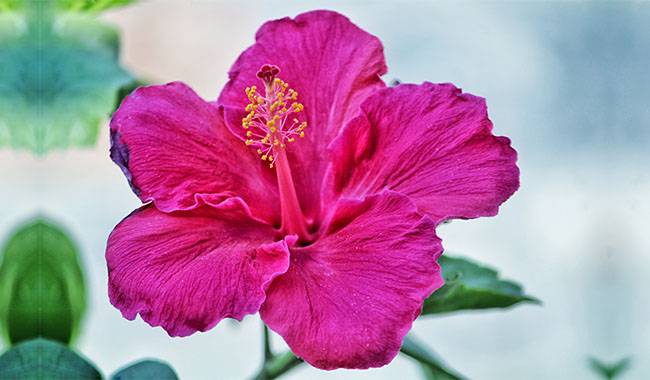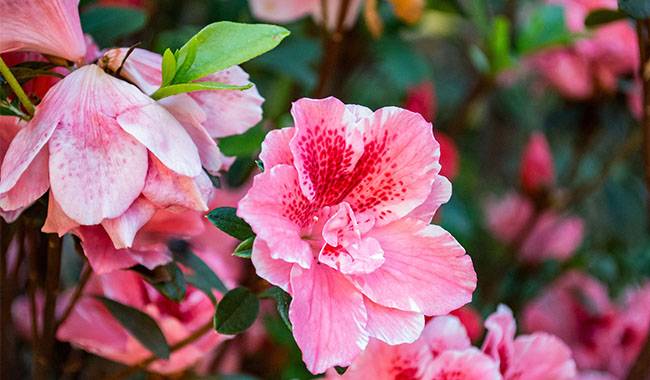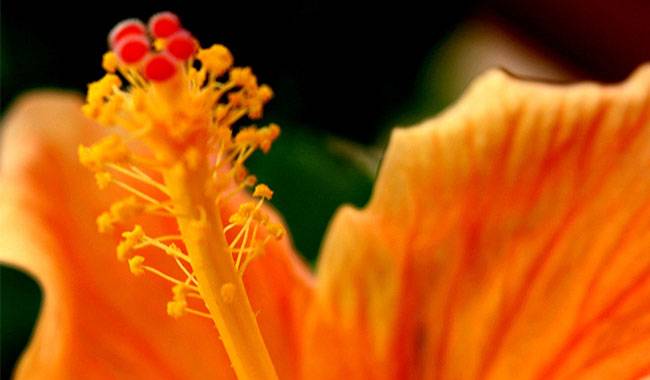
If Hibiscus was once considered boring, those days are long gone. Hibiscus plants have transformed from tiresome plants in clinics and school halls to garden staple displays. Potted Hibiscus plants display their abundant flowering ability in the summer garden and stay in top form for a long time. But they are also surprisingly attractive as houseplants. They require a lot of care and watering, but they are not prone to any changes except for a preference for humidity and fear of cold. They are fast-growing, brightly colored, and bring a joyful lush atmosphere to any indoor environment. You will learn how to grow Hibiscus plants in ThumbGarden’s article.
HIBISCUS PLANT DESCRIPTION
The place of beautiful houseplants in modern Hibiscus flowers is undeniable, but the green color of Hibiscus flower plants is underestimated. Glossy and fresh, it looks gorgeous despite its plainness.
Hibiscus, or Hibiscus rosa-Sinensis, comes from the mallow family and, depending on its formation, can be a shrub or transformed into a tree and a strict stem. Their height is determined by pruning and can be limited to less than 20 inches (50 cm) or more than 80 inches (2 m).
The leaves are oval or ovate with pointed tips and beautifully serrated edges. They are simple but striking due to their beautiful shiny surface and rich mid-green cool color.
Indoor Hibiscus flowers can last from February to October. Almost year-round, especially if they are kept in near-ideal conditions and get enough light in the winter. Ruffled, semi-stately and simple Hibiscus flowers are often draped with ornate ruffles and fringes around the edges and always impress with their purity and brightness.
Bicolor Hibiscus flowers or dazzling white, pink, red, yellow, orange, purple, violet – Hibiscus flowers are strikingly different in color. Funnel-shaped flowers with a darker spot on the throat, beautifully fused, long stamens that can exceed 4 inches (10 cm) in diameter. The flowers last only a few days.
Hybrid varieties (including longer-flowering groups) and varieties with abundant blooms (long-lived series, long-flowered, multi-flowered) are particularly popular today. Hibiscus flowers should be selected according to the color of the flowers.
GROWING CONDITIONS FOR INDOOR HIBISCUS FLOWERS

The thermophilic Hibiscus flower prefers stable and fresh air. It will brighten up any indoor environment but should not be placed away from windows.
Lighting and placement
Light-loving but sun-disliking Hibiscus flowers will prefer as bright a diffused light as possible, with no direct light. If size allows, they are best placed on east and west windowsills. Larger Hibiscus plants should be placed as close to a window as possible so that air can circulate freely around the shrub. In winter, take all available measures to raise the lighting to the usual level, either by moving them to the south windowsill or supplementing them with supplemental lighting.
However, Hibiscus plants do not like to be moved. Move the plants very carefully to increase the humidity in the air. Turning the plants around during flowering and germination can cause the buds to fall off.
Temperature control and ventilation
Hibiscus flower plants do not like high temperatures, but they do not mind elevated temperatures if the air is sufficiently humid. They grow best at 64-77 °F (18-25°C).
It is best not to let these temperatures drop below 59 °F (15 °C) even during the long winter months to keep the leaves growing – absolute minimum temperature: 50 °F (10 °C). The best overwintering temperature for Hibiscus is 60-64 °F (16-18 °C). You will need to compensate for the warmer conditions by increasing humidity.
Sudden temperature changes usually cause some leaves and buds to fall off. hibiscus flowers are better protected from the wind, but they cannot grow properly without fresh air. You can bring them into the garden in a warm place in summer out of direct sunlight.
HOW TO CARE FOR HIBISCUS FLOWERS AT HOME

Hibiscus flower responds to neglect by dropping its buds and flowers overnight, and more care issues can cause it to lose its foliage altogether. This plant needs attention, but caring for it is standard rather than complicated.
Watering and air humidity
The water-loving nature of Hibiscus plants should not be underestimated. They do not tolerate inadequate watering and are even painfully tolerant of mild dryness of the soil – heralding wilting leaves and loss of flower buds. During the peak growth period, water frequently and heavily, allowing only the top of the substrate to dry out. Do not make the situation too wet, and do not allow water to stagnate in the tray. Once Hibiscus begins its dormant period, waterless and sparingly, but do not allow the soil to dry out completely.
For Hibiscus flowers, it is best to provide at least moderate humidity (preferably 60%). The hotter the weather, the higher these numbers need to be. Hibiscus flower plants cannot tolerate being near air conditioning units and radiators. Misting is possible and desirable, but not during the flowering and germination stages. Humidifiers – from professional humidifiers to trays with wet pebbles – are still the best choice.
Hibiscus flower plants love showers. Dust should be removed from the leaves regularly – by hand, with a damp sponge for smaller plants or warm water for larger plants.
Feeding and Fertilizer Composition
Once Hibiscus begins to thrive, you should begin to fertilize intensively and frequently – apply half the usual dose weekly or the full amount every two weeks until the end of flowering. If it is still flowering in the winter, reduce the fertilizer application by 3-4 times, but do not stop.
Iron and magnesium are very important in Hibiscus flower fertilizers – you should always check their composition. Fertilizers for beautiful flowering plants are suitable for them. Too much nitrogen can lead to too much growth for flowering, but this should not be ruled out completely (lack of nitrogen can lead to yellowing of leaves and bare bushes underneath). You can alternate between liquid and foliar feeding.
Pruning and shaping
Hibiscus flowers need regular pruning to flower. Sanitary pruning can be done when necessary to remove damaged and dry leaves and branches, as well as unproductive weak shoots and “spikes.” But basic pruning is best done in the spring, at the first signs of growth – shortening all buds to 2 or 3 buds or allowing the plant to sprout and limiting its pruning. For strict forms, prune to the desired outline.
Transplanting, containers, and substrates
Hibiscus flowers are transplanted by gently handling the roots. Repot old containers when they become too crowded (every 2-3 years). The best time to transplant Hibiscus is in February.
These plants need sturdy, deep containers and a high drainage layer. Hibiscus flower plants need large containers but do not make them larger than 2 inches (5 cm). Hibiscus plants do not grow or flower well in cramped conditions, but they will not flower even if there is too much soil. A happy medium is needed for normal development.
Any loose substrate with a pH of about 6.0 can be used. It is best to add loosener and charcoal to a ready-made soil mix.
When no transplants are available, replace the top 2 inches (5 cm) of soil for the plants with a fresh and nutritious substrate.
After transplanting, Hibiscus plants require gentle watering and lighting to increase air humidity.
Diseases, pests and cultivation problems
Hibiscus plants are resistant to disease, except for rot that is watered excessively. However, common pests such as aphids, scabies, whiteflies, and spider mites. Simple control methods are not very effective, and insecticides are best used on Hibiscus flowers.
Hibiscus flower always reacts fiercely to big mistakes in care, dropping leaves, small lapses that may not be noticed but only under other ideal conditions. The most common problem is the loss of flower buds and some leaves. They may never open if there is a lack of moisture, fertilizer, or cold conditions. Any temperature fluctuations, moving and turning, poor light, insufficient nutrients, and overly dry soil can cause a loss of quality. Hibiscus flowers are susceptible to chlorosis due to watering with soft water or lack of iron.
Propagation of Hibiscus
The main method of propagation for Hibiscus flowers is cutting. The tops of young shoots are rooted under a mulch of light soil or water, avoiding overwatering and drying.
Cross-pollination is required to obtain seeds. Purchased seeds should be used fresh. As with most garden annuals, Hibiscus is sown shallowly, under glass, in a light-colored soil. Germination will require stable humidity and a temperature of 77-82 °F (25-28°C).







